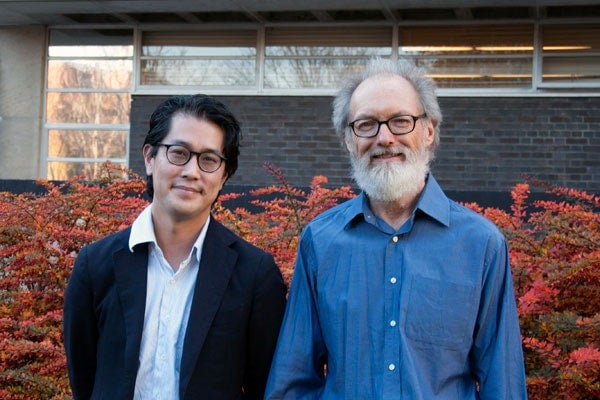
U of T physicists among team members receiving Breakthrough Prize in Fundamental Physics
Published: November 8, 2015
University of Toronto physicists are on two of the five teams receiving the Breakthrough Prize in Fundamental Physics tonight for major insights into the deepest questions of the Universe.
The prize will be awarded during a ceremony hosted by “Family Guy” creator Seth Macfarlane and broadcast in the United States on the National Geographic Channel.
This year’s prize goes to five experimental collaborations – Sudbury Neutrino Observatory (SNO), Super-Kamiokande (Super-K), KEK to Kamioka/Tokai to Kamioka (K2K/T2K), Daya Bay, and KamLAND – “for the fundamental discovery of neutrino oscillations, revealing a new frontier beyond, and possibly far beyond, the standard model of particle physics.”
Associate Professor Hirohisa Tanaka and Professor Emeritus John Martin of U of T’s department of physics are both members of the T2K and Super-K collaborations. Tanaka is currently the principal investigator of the T2K effort in Canada, and leads the overall analysis in the T2K collaboration.
T2K is a neutrino experiment designed to investigate neutrino oscillations: how neutrinos change from one “flavour” to another. Neutrinos are ghost-like particles that travel at nearly the speed of light and interact with matter so weakly that they can travel through the entire Earth like a light beam passing through a window pane. They have no electric charge, and have the smallest mass of all known particles.
Neutrinos come in three “flavours” – electron, muon, and tau. As they travel, they can oscillate from one flavour to another. In the T2K experiment, an intense beam of muon neutrinos generated at the Japan Proton Accelerator Research Complex (J-PARC) on the east coast of Japan were directed 295 kilometres across the country to Super-K, a gigantic underground detector in the mountains of western Japan. The beam was measured once before it left the J-PARC site and again at Super-K: the change in the measured intensity and composition of the beam is used to provide information on the properties of neutrinos. In June 2011, T2K announced the first-ever observations of the transformation or “oscillation” of muon neutrinos into electron neutrinos. Later results confirmed the observations.
“Our experiment has definitely shown one of the defining features of neutrino oscillations, namely the transmutation of one flavour of neutrinos into another via the quantum mechanical process of neutrino oscillation in a series of results spanning 2011-2013,” said Tanaka.
(Image below courtesy: Kamioka Observatory, ICRR (Institute for Cosmic Ray Research), The University of Tokyo)

Neutrino oscillation is a manifestation of a long-range quantum mechanical interference. Observation of this new type of neutrino oscillation leads the way to new studies of charge-parity (CP) violation which provides a distinction between physical processes involving matter and antimatter. CP violation in neutrinos in the very early universe may be the reason that the observable universe today is dominated by matter and no significant antimatter, which is one of the most profound mysteries in science.
The search for CP violation in neutrinos will be a major scientific quest in the coming years and T2K will continue to play a leading role. The T2K experiment expects to collect seven times more data in the near future, including data with an antineutrino beam for studies of CP violation in neutrinos.
Martin and Tanaka have been collaborators on T2K for about a decade.
“The main contribution from the University of Toronto, in collaboration with York University and TRIUMF, Canada’s national laboratory for particle and nuclear physics, is a device called the Optical Transition Radiation (OTR) beam monitor,” explains Martin. “This novel device allows us to image the intense proton beam just before it hits a carbon target which starts the process by which the neutrinos are created.”
Martin played a leading role in building the OTR, along with former U of T postdocs Alysia Marino and Mark Hartz (joint postdoc with York),Vanier Fellow and former graduate student Patrick de Perio and engineer Mircea Cadabeschi.
Monitoring the properties of the beam – its alignment, width, and direction with respect to the target – using the OTR is critical to the stable and successful operation of the experiment, as well as providing important input into determining the neutrino beam flux
The award-winning group of neutrino experiments has been much in the news this year: Takaaki Kajita and Art McDonald won the 2015 Nobel Prize in Physics for work they did at Super-K and SNO, respectively.
The T2K collaboration consists of more than 400 physicists from 59 institutions in countries including Japan, Canada, France, Germany, Italy, South Korea, Poland, Russia, Spain, Switzerland, the United States and the United Kingdom. The Canadian T2K group involves 40 scientists from eight institutions (University of Victoria, University of British Columbia, TRIUMF, University of Alberta, University of Regina, University of Winnipeg, York University, University of Toronto).
Canada was the first international partner to join the T2K collaboration, and has contributed to several parts of the experiment, including beamline monitoring, construction of a new near detector for T2K, and analysis and calibration of the near detector and the Super-K detector at the far end of the experiment.
The Breakthrough Prize in Fundamental Physics was founded in 2012 by Yuri Milner to recognize those individuals who have made profound contributions to human knowledge. It is open to all physicists — theoretical, mathematical, experimental — working on the deepest mysteries of the Universe.
The prize is sponsored by founders Sergey Brin and Anne Wojcicki, Jack Ma and Cathy Zhang, Yuri and Julia Milner, Mark Zuckerberg and Priscilla Chan to celebrate scientists and generate excitement about the pursuit of science as a career. The prize’s selection committee of renowned physicists includes Stephen Hawking.
See a video about T2K:
Kim Luke is a writer with the Faculty of Arts & Science at the University of Toronto



